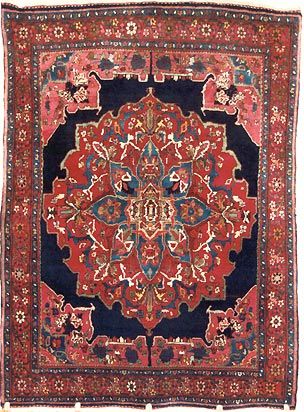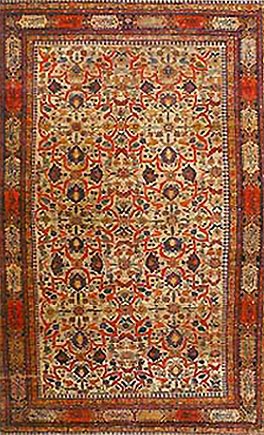Antique Persian rug is an essential part of Persian art and culture. Carpet-weaving is undoubtedly one of the most distinguished manifestations of Persian culture and art, and dates back to the Bronze Age. The earliest surviving corpus of antique Persian rugs come from the Safavid dynasty (1501-1736) in the 16th century.
The earliest surviving corpus of antique Persian rugs come from the Safavid dynasty (1501-1736) in the 16th century.
However, painted depictions prove a longer history of production. There is much variety among antique oriental Persian rugs of the 16th and 17th century.
Common motifs include scrolling vine networks, arabesques, palmettes, cloud bands, medallions and overlapping geometric compartments rather than animals and humans.
This is because Islam, the dominant religion in that part of the world, forbids their depiction.
Still, some show figures engaged either in the hunt or feasting scenes. The majority of these rugs are wool, but several silk examples produced in Kashan survive.
The major centers of antique Persian carpet production in Persia were in Tabriz (1500-1550), Kashan (1525-1650), Herat (1525-1650), and Kerman (1600-1650).
The majority of rugs from Tabriz have a central medallion and quartered corner medallions superimposed over a field of scrolling vine ornament, sometimes punctuated with mounted hunters, single animals, or animal combat scenes. Perhaps the most well-known of the Tabriz works are the twin Ardabil rugs most likely made for the shrine at Ardabil.
Kashan is known for its silk carpet production. Most famously, for the three silk hunting carpet masterpieces depicting mounted hunters and animal prey.
The Kashan rugs are among the most valuable in existence. One carpet, for example, is known to have been sold in Germany for $20,000 in 1969.
The Herat rugs, or ones of similar design created in Lahore and Agra, India, are the most numerous in Western collections. They are characterized by a red field with scrolling vine ornament and palmettes with dark green or blue borders.
The seven classes of Kerman rug were defined by May Beattie. She identified their unique structure and named it the “vase technique.” Carpet types in this group include garden carpets (ornamented with formal gardens and water channels) and the ogival lattice carpets.
 A fine and well-known example of the later was purchased by the Victoria and Albert Museum under the guidance of William Morris.
A fine and well-known example of the later was purchased by the Victoria and Albert Museum under the guidance of William Morris.
The influence of Persian carpets is readily apparent in his carpet designs.
An Antique Persian carpet is a piled or flat woven fabric hand-knotted in one of the traditional weaving areas of the Middle or Far East.
Genuine Oriental rugs and carpets come from Afghanistan, China, India, Iran, Nepal, Pakistan, Tibet, Turkey, some of the southern territories of the old Soviet Union.
Antique oriental Persian rugs are not made in Belgium or anywhere else in Western Europe or in the United States. No genuine Oriental rugs are made of nylon or polypropylene.
Antique Persian Rugs are either knotted with pile or woven without pile. A Persian Rug made by machine or any method other than hand knotting or hand weaving are not considered authentic Antique Persian Rug.
Return from Antique Persian Rug to Antique Oriental Rug